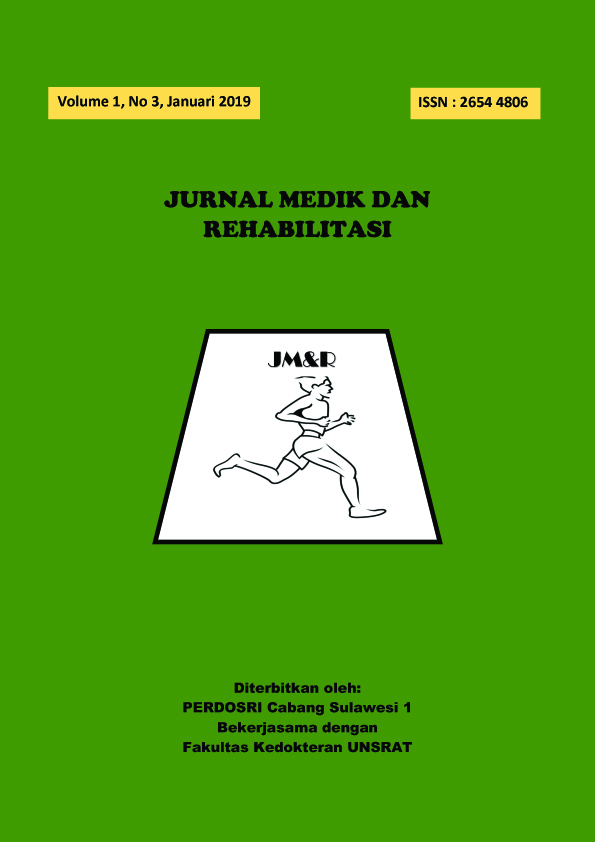STATUS ANTROPOMETRI PADA BAYI YANG DIRAWAT DI NEONATAL INTENSIVE CARE UNIT RSUP Prof. Dr. R. D. KANDOU MANADO
Abstract
Abstract: Anthropometric measurements is one of the routine examinations performed on newborns. It is a key to assess nutritional status, and predict long term health complications. The most frequently used parameters are gestational age, birth weight, birth length, and head circumference. This study aims to describe the anthropometric status of babies admitted to Neonatal Intensive Care Unit RSUP Prof. Dr. R. D. Kandou. This was a descriptive retrospective study, sampling was done by taking information from medical records of babies admitted to NICU from July 2016 to June 2018. The collected data was then processed using Excel Microsoft Office 2013 and presented in the form of a frequency distribution table. From this study, we found that there are 36,4% preterm, 63,3% aterm and 0,3% postterm babies admitted to NICU. The average birth weight of preterm babies is 1550,74 gram, aterm is 3037,66 gram, and postterm is 2500 gram. The average birth length of preterm babies is 39,37 cm, aterm is 47,22 cm, and postterm is 46 cm. The average head circumference of preterm babies is 28,68 cm, aterm is 33,53 cm, and postterm is 33 cm. We can conclude that the rate of low birth weight and short birth length babies admited to NICU RSUP Prof Dr. R. D. Kandou is still high.
Key Words: Anthropometry, Gestational Age, Birth Weight, Birth Length, Head Circumference
Â
Abstrak: Pengukuran antropometri adalah salah satu pemeriksaan yang rutin dilakukan pada bayi baru lahir. Ini adalah kunci untuk menilai status gizi bayi serta memprediksi komplikasi kesehatan jangka panjang. Parameter yang paling sering digunakan adalah usia gestasi, berat badan, panjang badan, dan lingkar kepala. Tujuan penelitian ini adalah untuk mengetahui gambaran status antropometri bayi yang dirawat di Neonatal Intensive Care Unit RSUP Prof. Dr. R. D. Kandou. Penelitian ini bersifat deskriptif retrospektif, dengan mengambil data rekam medis bayi yang dirawat di NICU RSUP Prof Dr. R. D. Kandou pada periode Juli 2016 – Juni 2018. Data yang terkumpul kemudian diolah menggunakan Microsoft Office Excel 2013 lalu disajikan dalam tabel distribusi frekuensi. Subjek penelitian ini berjumlah 330 orang. Dari hasil penelitian ini didapatkan bayi yang dirawat di NICU terdiri dari 36,4% bayi kurang bulan (BKB), 63,3% bayi cukup bulan (BCB) dan 0,3% bayi lebih bulan (BLB). Rerata berat badan lahir pada BKB adalah 1550,74 gram, pada BCB adalah 3037,66 gram, dan pada BLB adalah 2500 gram. Rerata panjang badan lahir pada BKB adalah 39,37 cm, pada BCB adalah 47,22 cm, dan pada BLB adalah 46 cm. Rerata lingkar kepala pada BKB adalah 28,68 cm, pada BCB adalah 33,53 cm, dan pada BLB adalah 33 cm. Dapat disimpulkan bahwa angka kejadian BBLR serta PBL pendek pada bayi yang dirawat di NICU RSUP Prof Dr. R. D. Kandou Manado masih tinggi.
Kata Kunci: Antropometri, Usia Gestasi, Berat Badan Lahir, Panjang Badan Lahir, Lingkar Kepala.
References
WHO. Global health observatory data : Neonatal mortality. [Online].; 2016 [disitasi 2 September 2018]. Tersedia di: http://www.who.int/gho/child_health/mortality/neonatal_text/en/.
Lissauer T, Fanaroff AA. At a glance neonatology Jakarta: Erlangga; 2010.
Direktori Kesehatan Anak Khusus Kemenkes RI. Pelayanan kesehatan bayi baru lahir. Dalam Panduan pelayanan kesehatan bayi baru lahir berbasis perlindungan anak. Jakarta: Kementerian Kesehatan Republik Indonesia; 2010.
Law CM. Significance of birth weight to the future. BMJ Journals: Fetal and neonatal edition. 2002; 86(1).
Dinas Kesehatan Republik Indonesia. Riset Kesehatan Dasar. 2013.
Harrison W, Goodman D. Epidemiologic trends in neonatal intensive care, 2007-2012. JAMA Pediatr. 2015;169(9):855-62
Calkins K, Devaskar SU. Fetal origins of adult disease. Curr proble pediatr adolesc health care. 2011;41(6):158-76
Lærum AMW, Reitan SK, Evensen KAI, Lydersen S, Brubakk A, Skranes J, et al. Psychiatric disorders and general functioning in low birth weight adults: a longitudinal study. Pediatrics. 2017;139(2)
Dinas Kesehatan Republik Indonesia. Riset Kesehatan Dasar. 2018
Amaliah N, Sari K, Suryaputri IY. Panjang badan lahir pendek sebagai salah satu faktor determinan keterlambatan tumbuh kembang anak umur 6-23 bulan di kelurahan Jaticempaka, kecamatan Pondok Gede, kota Bekasi. Jurnal ekologi kesehatan. 2016;15(1):43-55
Prawirohartono EP, Nurdiati DS, Hakimi M. Prognostic factors at birth for stunting at 24 months of age in rural Indonesia. Paediatrica Indonesia. 2015;56(1):48-56
Black RE, Allen LH, Bhutta ZA, Caulfield LE, de Onis M, Ezzati M, et al. Maternal and child undernutrition: global and regional exposures and health consequences. Lancet. 2008;371:243–60.
Olofin I, McDonald CM, Ezzati M, Flaxman S, Black RE, Fawzi WW, et al. Associations of suboptimal growth with allcause and cause-specific mortality in children under five years: a pooled analysis of ten prospective studies. PLoS one. 2013;8:e64636.
Grantham-McGregor S, Cheung YB, Cueto S, Glewwe P, Richter L, Strupp B. Developmental potential in the first 5 years for children in developing countries. Lancet. 2007;369:60–70.
Nellhaus G. Head circumference from birth to eighteen years. Pediatrics. 1968;41(1)
Menounou A. Head size: is it important. Advances in clinical neuroscience and rehabilitation. 2011; 11(2):16-20.
Hanzlik E, Gigante J. Microcephaly. Children. 2017;4(6):47

